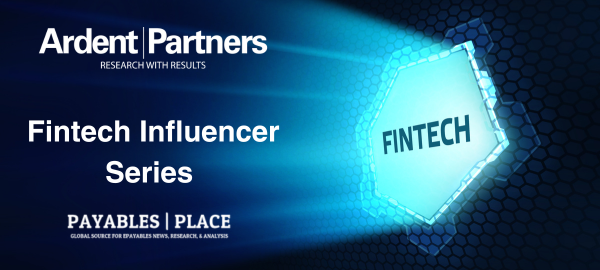We continue our FinTech Influencer Series, which highlights innovative voices in the world of Accounts Payable (“AP”) automation. This series is the go-to spot for progressive thoughts on how technology, transformational thinking, and revolutionary ideas are changing how AP work gets done. Today we are speaking with Daniel Saraste, Senior Vice President of Product Marketing and Innovation at Medius, the company behind MediusFlow. Over the last 20 years, Daniel has held executive roles and been responsible for implementing, selling, developing and managing cloud solutions for Spend Analytics, Sourcing, Contract Lifecycle Management, Operational Procurement and Invoice Automation.
Ardent Partners: Good afternoon Daniel and welcome. Let’s get started. Can you please provide me with your perspective on the ePayables market today?
Daniel Saraste: The ePayables market today is immensely exciting. The market has grown continuously since Medius was founded in 2001, and the growth continues to accelerate every year. It, however, remains a very fragmented market and some confusion still exists as to what is meant by the term ‘ePayables’. At Medius, we define it as including the basics of going from paper-based chaos to a highly automated (and I mean ‘highly’ automated, not just working on a computer) process where touchless processing, audit trails, efficient collaboration, and analytics are just table stakes. When you have achieved a scalable and efficient AP process then, and only then, will you be able to effectively control your DPO, cash flow and working capital, aka the lifeblood of your organization, as well as how and when you pay your suppliers. ePayables covers this entire process and allows you to go step-by-step on your journey to more effective management of your most precious resource: cash.
Ardent: What should we be paying attention to now and in the future (technologies, trends, etc.)?
DS: Technology in the ePayables space has reached a level of maturity where just-getting-things-done is no longer the primary objective, but rather a starting point. Today’s solutions are focusing more on analytics and insights gained from Big Data. Leaders in the ePayables market are leveraging buyer data across organizations to provide benchmarks and actionable insights that enable customers to focus on real, bottom-line, value-adding activities such as spend visibility for indirect materials, purchases, and optimization of discounts vs. DPO.
The marriage of finance and technology offers new and exciting options for mid-market companies in terms of how they can optimize their discount-vs-cash flow (DPO vs. Cost). For example, what started with Dynamic Discounting for treasury departments at larger, enterprise-sized organizations, has now trickled down to the mid-market in the form of virtual cards (Vcards) and other financing options.
Blockchain, Robotic Process Automation (RPA), Machine Learning (ML), and Artificial Intelligence (AI) on top of Big Data are all worthy of our attention. ML/AI is the one that is already delivering tangible results. RPA has been a cash cow for consulting companies for decades and has more recently been incorporated into many invoice receipt and capture offerings. Blockchain has the potential to disrupt how business is done, but this is largely dependent on free-trade and cross-border collaboration continuing to be a driver of growth and mutual prosperity.
Long-tail spend management is another area to keep an eye on going forward. ML-driven automated spend categorization will enable organizations to address categories of spend that until now have not been possible due to high cost of analyzing them versus the potential savings yield. Technology has created a shift in that balance, opening up virtually all categories of indirect spend for optimization.
Ardent: How has the market/industry changed in the past five years and what do you think it will look like five years from now?
DS: These are amazing times to be in the industry. The cloud has gone from the “innovative alternative” to the mainstream way of delivering B2B software. Five years ago we still had to explain the benefits of cloud and the difference between cloud, hosting, hybrids, etc. to prospects. Nowadays, the market understands the incredible benefits of true multi-tenant cloud with continuous and high-speed innovation, out-of-the-box connectivity to a pre-existing cloud ecosystem, and completely predictable lifecycle cost to name a few. With this comes the preference towards best-of-breed and/or best-practices, rather than a focus on time and material and customization of platforms.
As a direct consequence of this, the mid-market is now being served better, and buyers are able to reap the same technological benefits as the enterprise-sized organization, but without having to pay for bespoke development and a need to employ large internal IT departments.
Within five years the industry will definitely experience some consolidation, along with the emergence of a network ecosystem where best-of-breed solutions are pre-connected so that customers are able to use multiple solutions simultaneously with data and transactions flowing freely between systems without the need to pay for complicated integration projects. As an example, MediusFlow is already able to seamlessly connect to cloud-based ERP systems, eInvoicing networks, Business Intelligence, and spend analytics solutions.
Ardent: As an executive at a FinTech solution provider, what keeps you up at night?
DS: Pure excitement! …and sometimes my 4 and 6 year old boys. There is so much potential to leverage the technology that is already available in the market. The pace of innovation right now holds great promise for better use of working capital, more, well-informed business decisions and leaner, more efficient, processes. I’m super excited to be where we are now with Medius and riding this wave of innovation is both exciting and gratifying.
Ardent: On a personal note, what is your favorite book or movie and why do you like it?
DS: Debt: The First 5000 Years by David Graeber, is an extremely well-written and entertaining review of the recent history of human interaction with the concept of debt and currencies. History tells us a lot about what the constants are in human drive and motivation, and brings us valuable insight when assessing the viability and longevity of new innovations in Fintech. I recommend it to anyone in Finance or Fintech.
Ardent: Thank you Daniel for your time and sharing your insight on the market.



